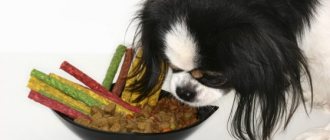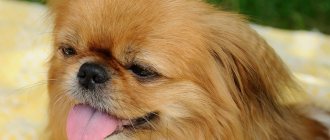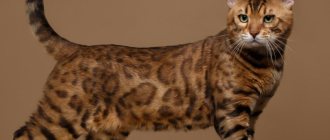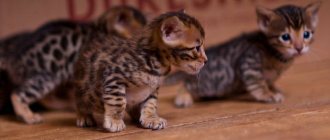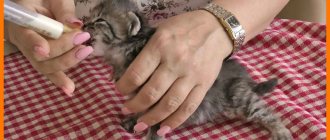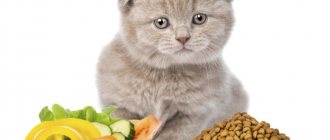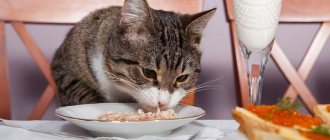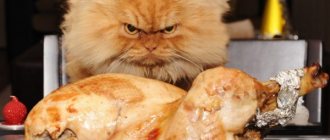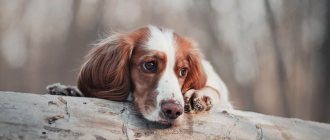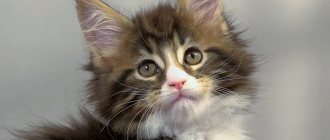What to feed an adult Bengal cat
The choice of diet depends on the following factors:
- The type of food that the breeder introduced the pet to.
- Features of the breed, age group and health level of the animal (separate lines for early complementary feeding, neutered cats and pregnant cats).
Important! Food prepared for people can be detrimental to a pet's health due to the possibility of poisoning by toxic compounds.
Natural diet
The choice of many owners is natural food for Bengal breeds, close to the diet of predatory breeds of animals, which is more physiological and safe. This option allows you to control the freshness and quality of food for your spotted pet.
The choice of a balanced diet is based on the age characteristics and health status of the animal, and the individual preferences of the cat. The approximate composition can be distributed as follows:
- Lean meat - about 60% of the daily value, preferably chicken, turkey, beef and rabbit. The meat must be cut into pieces, removing the bones, doused with boiling water or kept in the freezer for 7-10 days to kill parasites and pathogens. If a Bengal kitten has an intolerance to raw meat, the cut pieces of the product must be boiled.
- Fish is not recommended for Bengal cats due to the high sensitivity of the gastrointestinal tract.
- Eggs - no more than 2 times a week, they can be raw or boiled, chicken eggs give the yolk, and quail eggs are allowed to be eaten whole.
- Porridge is a valuable source of energy; preference is given to rice and buckwheat cereals; the high gluten content in semolina and millet does not allow them to be given to cats.
- Fermented milk products are allowed with no more than 9% fat content, these are cottage cheese, kefir, natural yogurt without additives. Milk should not be given due to possible lactose intolerance.
- Vegetables are chopped into small pieces and grated, mixed with pieces of meat.
- By-products are introduced into the diet no more than 2 times a week; boiled liver, lung and heart, and chicken gizzards are chosen.
- Cheese is allowed among treats and can be used to pamper your pet no more than 2 times a week.
To prevent constipation, add 1 teaspoon of olive or flaxseed oil to food. If you don't have time to prepare fresh food, you can freeze 1-2 servings for future use, but do this extremely rarely.
The temperature of the food for both kittens and adult Bengals should correspond to the room temperature; the food will not be cold or hot.
Industrial feed
When choosing from food lines from reputable manufacturers, consider the age, activity level and health of your Bengal kitten. Recommendations from a veterinarian or breeder will help you figure out which brand to choose. In case of illness, treatment lines are recommended.
It is recommended to purchase feed from European manufacturers, as their compliance with AAFACO standards is guaranteed through testing for nutritional content.
Before use, carefully study the composition:
- The ingredients are listed in descending order, with the type of meat listed first.
- The presence of grains - corn, wheat, and soybeans - increases the possibility of disruptions in metabolic processes, which leads to obesity in pets.
- The content of vegetable protein in food for a Bengal kitten should be minimal.
Feeding with dry granulated food implies free access to a drinking bowl, as liquid consumption increases by 2–3 times.
The most suitable option would be dry food for Bengal cats from RoyalCanin, developed taking into account the increased need for nutrients and containing useful additives and vitamins.
The only concern is possible allergic reactions to dehydrated poultry meat and grains contained. Therefore, when choosing food, you need to monitor your pet’s reaction.
Wet packaged canned food is produced by the following manufacturers: Leonardo, Applaws, 1st Choice, AlmoNature, Grandorf; they meet all requirements due to their high-quality composition, the content of dietary grade meat and other components for the health of the cat.
Mixed food type
Combined nutrition involves feeding high-quality dry food with additional nutrition in the form of cereals, meat, fish, cottage cheese and eggs. This is only suitable for adults, since kittens' teeth are not yet developed enough for heavy food.
Veterinarians usually do not welcome this approach due to the different structure of the food consumed, which leads to disruptions in the digestive system of Bengal cats and the occurrence of dysbiosis.
Which diet is better
There are several approaches to the type of nutrition of a Bengal kitten:
- When choosing, feeding high-quality ready-made food is better and more convenient, as it allows you to properly feed your Bengal cat and meet the needs of his body. Too cheap products contain ballast substances and additives that are unacceptable for Bengals. For the same reason, you should not feed Bengals from your table to prevent negative health consequences.
- A natural diet will be more natural, but also more dangerous due to the consumption of raw foods that may contain parasites. Not so healthy dry food will be more balanced in composition and convenient for feeding if you are often away from home.
- It is very difficult to compose a daily diet from natural products on your own; to do this, you need to carefully calculate the amount of necessary products based on the recommendations of a veterinarian. If you choose natural food, you will have to go to the store more often for fresh food, while you buy ready-made food once every 1-2 months.
Description of the breed
The birthplace of Bengal cats is America. This species appeared in 1963 by crossing a leopard with a cat. At the same time, the oldest breed is the Egyptian Mau. She is considered to be the ancestor of all modern cats. The greatness, stature, plasticity, soft and smooth movements of the animal indicate that, perhaps, once upon a time all furry creatures were not pets at all. With their skills and habits, they could easily survive in the wild. The owners of Bengal cats claim that they have a serious and harmful disposition. Representatives of the breed love affection and attention from humans.
These cats are medium in size. They have a muscular body. True, in some areas of Asia there are wild Bengal cats, which reach a length of 80 cm. Scientists explain this by their habitat. The Bengal cat's tail is larger in diameter than that of a normal cat, but not long. Their paws are round. Cats of this breed have a long neck and a wide muzzle. The ears are medium in size and slightly tilted forward. The eyes are large and oval in shape. As for their color, Bengal cats have a variety of colors, except for blue. As for the coat color, it can be anything, but it always has clearly visible black or brown spots. The most prized are Bengals with leopard-print rosettes, which are a distinctive feature of this breed.
Vitamins and supplements
The presence of vitamin substances and additives is necessary if you give your animal natural food, because the finished food already contains vitamins for complete nutrition.
Natural sources of vitamins include fish oil, bone meal and brewer's yeast. Complex vitamin supplements are taken in courses, no more than 1-2 times a year, which helps strengthen the immune system, prevent joint problems and improve skin condition.
The choice can be made from the famous brands Canina, Gimpet, Sanal after consultation with a veterinarian.
The best ready-made diets
Having analyzed the cat food market, veterinary specialists and breeders have identified the most optimal production rations that best satisfy the needs and characteristics of purebred representatives.
- WildCat Etosha . Dry natural food from a German manufacturer. Belongs to the category of holistic products, that is, the most balanced products. It is distinguished by its high protein content (approximately 46%) and the presence of flaxseeds.
- Orijen Six Fish Cat . Canadian food based on fish products. Rich in proteins. Also includes vegetables, fruits, grain products.
- CARNILOVE Salmon for Adult Cats . This food is made by a Czech manufacturer. Created specifically for those breeds of cats that are as close as possible to their predatory ancestors. 36% consists of crude protein.
- Royal Canin Bengal Adult . Premium product from a French company. Ideal for Bengals over one year of age. 40% consists of proteins.
- Eukanuba Adult with Chicken . Quality product from the Netherlands. It is high in protein and also includes fatty acids and probiotics.
Ready-made foods are also great for small kittens, for example, from Brit Care, Fitmin For Life, Leonardo, Summit.
If the owner has opted for finished products, it is important to ensure that the pet has constant access to fresh water. In addition, the owner should not feed the Bengal with vitamins, since food from the holistic and super-premium categories contains the daily requirement of all minerals. Otherwise, hypervitaminosis will occur, which causes discomfort and discomfort in the pet.
Water
The presence of water in the Bengal cat's drinking bowl must be constant. Access to water should not be limited, especially if feeding dry food. Low water consumption by a cat involves supplementing with a syringe starting at the age of 2 months. Otherwise, there is a high risk of urolithiasis and disruptions in the gastrointestinal tract.
A diet of dry food is accompanied by the use of drinking fountains, which are preferred by both adult Bengal cats and kittens.
Advice
It is important that growing children have a balanced diet! What to feed Bengal kittens? From dry food for babies, you need to choose those that have the inscription: “for kittens” or “for pregnant and lactating cats.” It should not be the cheapest products from unknown brands. What to feed Bengal kittens up to 4 months? An excellent option would be Royal Canin 34 food. You can feed your pet with it for up to six months. Up to a year, Sanabelle dry food for kittens and teenagers is ideal.
What is forbidden to feed a Bengal?
Spotted pets should not be fed the following foods to avoid allergic reactions, gastrointestinal problems and metabolic problems:
- fatty meats, lard and fried foods due to the inability to digest fatty foods;
- meat products containing tubular bones, which can injure the esophagus and stomach;
- river fish due to the presence of small bones;
- sausages and products based on them, due to the content of dyes, preservatives and artificial additives;
- potatoes, legumes, tomatoes, which can upset digestion;
- grapes, raisins, citrus fruits, avocados and persimmons, which cause allergies;
- onions and garlic, which are not recommended for consumption by cats because they destroy red blood cells;
- sweets and baked goods, chocolate, which increases the secretion of sebum and rapid contamination of the coat.
Important! Under no circumstances should food for Bengal cats and kittens be expired; storage conditions must be observed to avoid spoilage.
